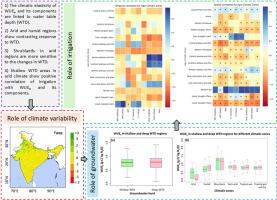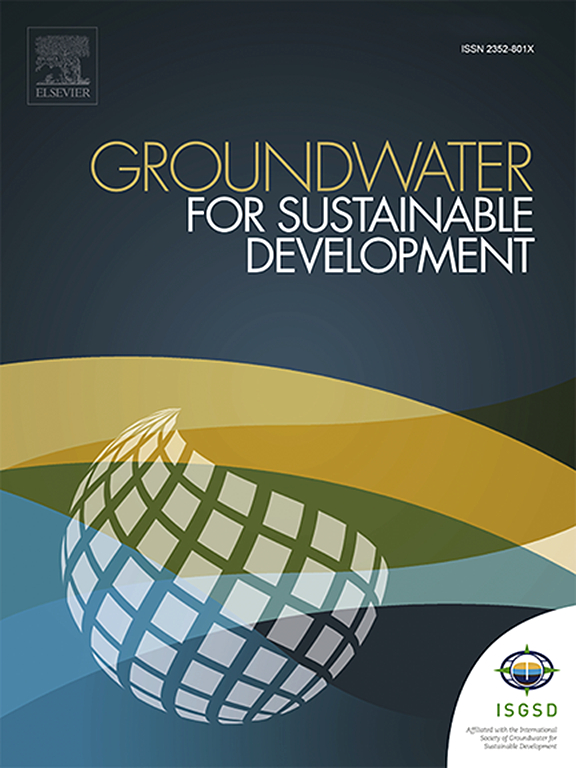Investigating the role of groundwater in ecosystem water use efficiency in India considering irrigation, climate and land use
IF 4.9
Q2 ENGINEERING, ENVIRONMENTAL
引用次数: 0
Abstract
Terrestrial ecosystems (TEs) play a crucial role in carbon sequestration and climate regulation. While interactions between surface water and ecosystems are well-studied, groundwater-ecosystem relationships remain poorly understood, particularly in groundwater-dependent regions like India. This study investigates the relationship between water table depth (WTD) and ecosystem productivity across India, considering the variation in irrigation practices, land use and climate types, from 2000 to 2021. We employ Ecosystem Water Use Efficiency (WUEe), the rate of carbon uptake per unit of water consumed, to examine these interactions at different spatial scales. Our findings reveal a strong link between WUEe and WTD. Shallower WTD regions, such as the lower Himalayas and Northeast India with forests and dominated by a wet/humid subtropical climate, exhibit higher WUEe (1.5–3.5 g C/kg H2O). Whereas deeper WTD regions like northwest India, characterized by shrublands and an arid climate, display lower WUEe (<1 g C/kg H2O). This suggests vegetation in arid/semi-arid regions shows higher sensitivity to water availability compared to wetter areas. This is also evident by a declining WUEe trend and increasing elasticity of WUEe () to interannual climatic variability with increasing WTD in these regions. Furthermore, the study identifies potential unsustainable groundwater use for irrigation in areas like the Trans Gangetic plains. Irrigation has a strong correlation with evapotranspiration (ET) (r = 0.4–0.6) in deep WTD zones, but no correlation with WUEe. This implies that intense and unsustainable irrigation might disrupt the natural water use strategies of vegetation. This research, by improving understanding of these interactions, aims to contribute to the sustainable management of India's groundwater resources.

考虑灌溉、气候和土地利用因素,调查地下水在印度生态系统用水效率中的作用
陆地生态系统(TE)在碳封存和气候调节方面发挥着至关重要的作用。虽然地表水与生态系统之间的相互作用已得到深入研究,但人们对地下水与生态系统之间的关系仍然知之甚少,尤其是在印度等依赖地下水的地区。本研究调查了 2000 年至 2021 年印度各地地下水位深度(WTD)与生态系统生产力之间的关系,同时考虑了灌溉方式、土地利用和气候类型的变化。我们采用生态系统水利用效率(WUEe),即单位耗水量的碳吸收率,来研究不同空间尺度上的相互作用。我们的研究结果表明,WUEe 与 WTD 之间存在密切联系。WTD较浅的地区,如喜马拉雅山下和印度东北部的森林地区,以湿润/潮湿的亚热带气候为主,WUEe较高(1.5-3.5 g C/kg H2O)。而印度西北部等WTD较深的地区,以灌木林地和干旱气候为特征,WUEe较低(1 g C/kg H2O)。这表明,与湿润地区相比,干旱/半干旱地区的植被对水分供应的敏感性更高。干旱/半干旱地区的植被对水分供应的敏感性更高,这一点还表现在干旱/半干旱地区的水分利用效率呈下降趋势,而且随着 WTD 的增加,水分利用效率对年际气候变异的弹性(εWUEe)也在增加。此外,该研究还发现了外恒河平原等地区潜在的不可持续的地下水灌溉用途。在深WTD地区,灌溉与蒸散量(ET)有很强的相关性(r = 0.4-0.6),但与WUEe没有相关性。这意味着高强度和不可持续的灌溉可能会破坏植被的自然用水策略。这项研究旨在通过加深对这些相互作用的理解,促进印度地下水资源的可持续管理。
本文章由计算机程序翻译,如有差异,请以英文原文为准。
求助全文
约1分钟内获得全文
求助全文
来源期刊

Groundwater for Sustainable Development
Social Sciences-Geography, Planning and Development
CiteScore
11.50
自引率
10.20%
发文量
152
期刊介绍:
Groundwater for Sustainable Development is directed to different stakeholders and professionals, including government and non-governmental organizations, international funding agencies, universities, public water institutions, public health and other public/private sector professionals, and other relevant institutions. It is aimed at professionals, academics and students in the fields of disciplines such as: groundwater and its connection to surface hydrology and environment, soil sciences, engineering, ecology, microbiology, atmospheric sciences, analytical chemistry, hydro-engineering, water technology, environmental ethics, economics, public health, policy, as well as social sciences, legal disciplines, or any other area connected with water issues. The objectives of this journal are to facilitate: • The improvement of effective and sustainable management of water resources across the globe. • The improvement of human access to groundwater resources in adequate quantity and good quality. • The meeting of the increasing demand for drinking and irrigation water needed for food security to contribute to a social and economically sound human development. • The creation of a global inter- and multidisciplinary platform and forum to improve our understanding of groundwater resources and to advocate their effective and sustainable management and protection against contamination. • Interdisciplinary information exchange and to stimulate scientific research in the fields of groundwater related sciences and social and health sciences required to achieve the United Nations Millennium Development Goals for sustainable development.
 求助内容:
求助内容: 应助结果提醒方式:
应助结果提醒方式:


